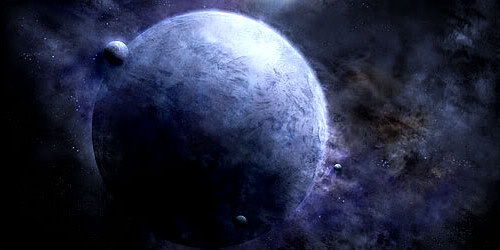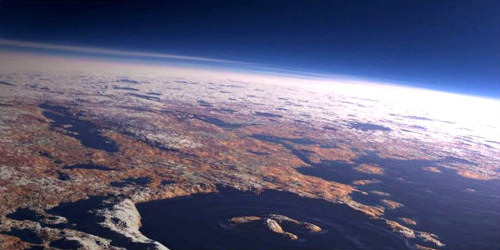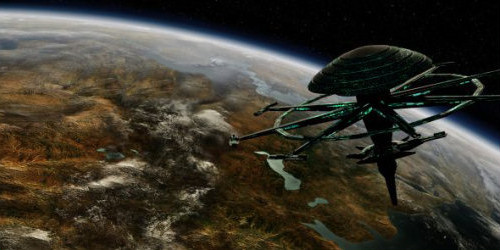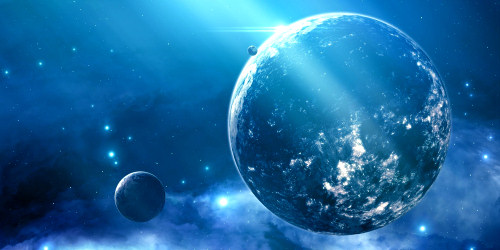03 - Notable Planets
Created by Commander Morgan Tarin on 24 Oct 2023 @ 11:47am
Table of Contents:
3.1 Earth

Name: Earth
Type: Class M - Terrestrial
Survey Status: Charted
System Location: Habitable Zone
Relative Position (x,y,z): (-25.1, 145, -0.22) M km
Age: 4.54 B years
Mass: 1.00 Earths
Diameter: 12,742 km
Density: 5.52 g/cm3
Velocity: 29.8 km/s
Temperature: 17.8 C
Composition: Water, Iron, Silicate
Atmosphere: Nitrogen, Oxygen
Satellites: 1 moon
Rings: None
Orbital Radius: 1.00 AU
Orbital Eccentricity: 0.016 (~1.5%)
Orbital Period: 365 days
Rotational Period: 23.9 hours
Rotation (x,y,z): (23.5, 0, 0) degrees
NOTABLE ORBITAL FACILITIES
- Starbase 001 (Stardock Class)
- McKinley Station
- Orbital Office Complex
- Luna Shipyards
- Lunaport
NOTABLE PLANETARY FACILITIES
- Starfleet HQ (San Francisco, CA)
- Starfleet Academy (San Francisco, CA)
- Advanced Starship Design Bureau (New York, NY)
- San Francisco Fleet Yards (San Francisco, CA)
- Federation Headquarters (Paris, France)
DESCRIPTION
- Earth is the homeworld of the Human race, an industrialized and flourishing Class M planet also known as the 'Blue Planet' due to its large proportion of surface water. It's axis is tilted approximately 23.5 degrees which gives it four major seasons - Spring, Summer, Fall, and Winter. Temperatures vary significantly across the planet depending on the region and the season, making the world a very diverse place for all types of plant and animal life. Earth has one moon, Luna, which orbits outside of its Roche limit and is tidal locked to the planet. Unlike other moons, Luna is extremely large in proportion to its planet (about 27% the size of Earth) which means its gravity heavily influences both weather and water tides on Earth.
- Earth has suffered several catastrophic 'World Wars' during its existence as the result of warring Human factions, and has also been heavily mined and exploited. Radiation and carbon dioxide levels were once dangerously high across most of the planet at the end of the 22nd century, but innovation, technology, and lifestyle changes have returned those levels to normal in the 24th century. Earth has a large population of almost 8 billion, mostly Humans but also many other races from the Alpha and Beta Quadrants. The planet is the home of Starfleet Command and the capitol of the United Federation of Planets.
3.2 Kreanus

Name: Kreanus
Type: Class R/M - Rogue Terrestrial
Survey Status: Charted
System Location: No parent solar system
Relative Position (x,y,z): N/A
Age: 6.32 B years
Mass: 0.9 Earths
Diameter: 10,507 km
Density: 3.528 +/- 0.006 g/cm3
Velocity: 2.558 km/s
Temperature: -23 C
Composition: Water, Iron, Silicate
Atmosphere: Nitrogen, Oxygen
Satellites: 3 moons
Rings: None
Orbital Radius: N/A
Orbital Eccentricity: N/A
Orbital Period: N/A
Rotational Period: 12.65 hrs
Rotation (x,y,z): (12.6, 3, 0) degrees
DESCRIPTION
- Kreanus is covered in water approximately 100 km deep, half of which is ice and the other half still liquid due to the extreme volcanism and high amount of magnetic movement of the core. Thermal vents dot the remaining ocean floor with a high-temperature fluid/rock interaction forms reduced gases (H2S, H2, and CH4) that dissolve in hydrothermal fluid. Representative redox reactions that produce H2S-rich community of thermophilic and hyperthermophilic communities along with remaining communities of other organisms. Since there is no sun, the primary producer of food chain source is a sulfur reducing bacteria. Thermolysis and radiolysis decomposition of the liquid water are thought to provide the necessary oxygen still remaining in the atmosphere and provide oxygen for the remaining communities of organisms.
- Kreanus is a rogue planet which means it has no parent star(s). It was most likely ejected from its solar system several billion years ago, and has been floating free within the Paulson Nebula ever since. Because the planet lacks a primary solar radiation source such as a sun to heat its surface, the terrestrial world has frozen over many eons ago. Despite its predicament, however, the planet was once a Class M world and still retains many life-supporting features. Below the plants thick ice surface lies multiple liquid oceans, volcanic activity, and a still-spinning molten core which provides the world with a strong atmosphere. Life cannot sustain itself on Kreanus' surface due to the extreme cold temperatures, but beneath enough layers of ice and rock, there is still a habitable world to be found.
3.3 Lyshan III

Name: Lyshan III
Type: Class K - Adaptable (Terraforming in progress)
Survey Status: Charted
System Location: Cold Zone
Relative Position (x,y,z): (-25.2, 243, 4.86) M km
Age: 3.87 B years
Mass: 9.34 moons
Diameter: 6,942 km
Density: 3.94 g/cm3
Velocity: 23.2 km/s
Temperature: -17.9 C
Composition: Water, Iron, Silicate
Atmosphere: Nitrogen, Argon, Oxygen, Carbon Dioxide
Satellites: 1 moon
Rings: None
Orbital Radius: 1.63 AU
Orbital Eccentricity: 0.09 (9%)
Orbital Period: 2.07 years
Rotational Period: 1.23 days
Rotation (x,y,z): (27.1, 0.5, 0.1) degrees
DESCRIPTION
- A Mars-like planet located in the Lyshan system, Lyshan III is a small mineral-rich world located just outside of its stars' habitable zone. Due to its small size and the cold temperature afforded to it by its relative position in the solar system, Lyshan III has a naturally thin atmosphere because atmospheric particles do not have enough gravity to keep them contained in orbit of the planet. Terraforming efforts have been underway over the past five years which have restored the once-dry oceans, atmospheric oxygen levels, and slightly raised the surface temperature, however the process is ongoing and the planet is currently uninhabitable without special environmental protection. Lyshan III has one small barren moon which is tidal locked.
- Initially discovered as a barren, dry, and dusty world, it was soon discovered that Lyshan II contained a plethora of uridium ore deposits several kilometers below the surface crust. The planet is strategically located along the Federation-Cardassian border, and has proven to be an invaluable source of uridium which is used for Cardassian starship construction. Lyshan III is a join-mining colony composed of UFP and Cardassian Union laborers, and it represents the latest post-Dominion War trade cooperation agreements between the Cardassian Union and the UFP.
3.4 Rigel VII

Name: Rigel VII
Type: Class M - Terrestrial
Survey Status: Charted
System Location: Habitable Zone
Relative Position (x,y,z): (137, -28.2, -0.39) M km
Age: 3.9 B years
Mass: 1.27 Earths
Diameter: 13,799 km
Density: 5.6 g/cm3
Velocity: 31.8 km/s
Temperature: 18.4 C
Composition: Water, Iron, Silicate
Atmosphere: Nitrogen, Oxygen
Satellites: 1 moon
Rings: None
Orbital Radius: 0.89 AU
Orbital Eccentricity: 0.02 (2%)
Orbital Period: 361 days
Rotational Period: 32.8 hours
Rotation (x,y,z): (-6.72, 16.8, 111) degrees
DESCRIPTION
- Rigel VII is the seventh planet in the Rigel system, a very populated solar system with several habitable worlds and moons. Rigel VII is also known as the Orion homeworld and was one of the first Orion colonies established after the First Migration from the original homeworld in the Orion system almost a thousand years ago. A large Class M planet about 120% the size of Earth, it has a relatively warm average temperature of 18.4 degrees and long days lasting almost 33 hours. Rigel VII has one small moon which orbit outside of its Roche limit and keeps the night sky very bright with its reflection of solar light. Like most moons, including Luna, it is tidal locked.
- A world inhabited primarily by Orions of all complexions, Rigel VII is a booming cultural and commerce center within the Beta Quadrant. It is famous for its elegant beaches and castle-like architecture. It's capital city, Vajripam, is the largest and most exquisite population center which supports close to 7 million inhabitants and is home to a plethora of planetary trading ports. Because Orions trade and deal in all types of commerce -- even the illegal kind -- there are often many ships and personnel coming and going from Vajripam, making it a very transient and culturally diverse area. Rigel VII is an Orion colony and is therefore not a chartered world of the UFP, and their independent sovereignty has allowed the world a great deal of economic, social, and cultural growth.
3.5 Setisar VI

Name: Setisar VI
Type: Class M - Terrestrial
Survey Status: Charted (USS Galileo in 2389)
System Location: Habitable Zone
Relative Position (x,y,z): (-25.1, 145, -0.23) M km
Age: 4.1 B years
Mass: 0.84 Earths
Diameter: 12,233 km
Density: 5.5 g/cm3
Velocity: 31.1 km/s
Temperature: 12.2 C
Composition: Water, Iron, Silicate
Atmosphere: Nitrogen, Oxygen
Satellites: 2 moons
Rings: None
Orbital Radius: 1.04 AU
Orbital Eccentricity: 0.02 (2%)
Orbital Period: 388 days
Rotational Period: 29.5 hours
Rotation (x,y,z): (10.8, 0.9, 1.2) degrees
DESCRIPTION
- Setistar VI is a primeval Class M world located within the Setisar system deep within the Setisar Nebula. Its existence, as well as that of its solar system, was unknown to Federation scientists until it was discovered by USS Galileo in late 2389. Slightly smaller in size than Earth, Setisar VI orbits its sun once every 388 days and has an average surface temperature of 12 degrees Celsius. Due to its slightly slower axial rotation, a day on Setisar VI is approximately 30 hours long.
- The planet has no rings, but has two moons which orbit outside of its Roche limit. Both of these moons are tidal locked, meaning they always display the same face towards the planet (similar to Earth's moon, Luna). Setisar VI has an axial tilt of only 10.8 degrees, which means it only has two seasons: fall and spring. Because of the relatively low tilt, both seasons are mild and the weather across the planet is generally very stable and pleasant, albeit slightly chilly.
Categories: Science Manual

